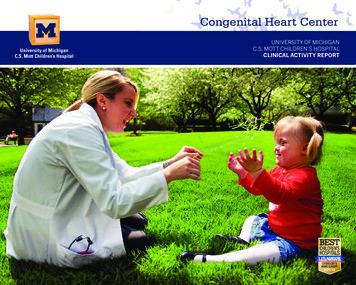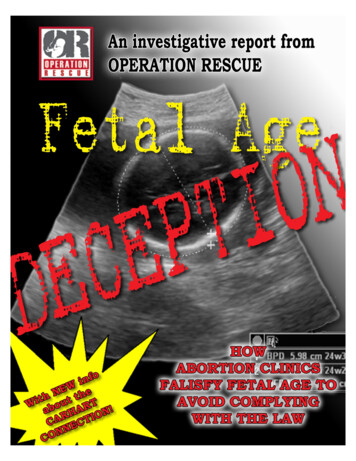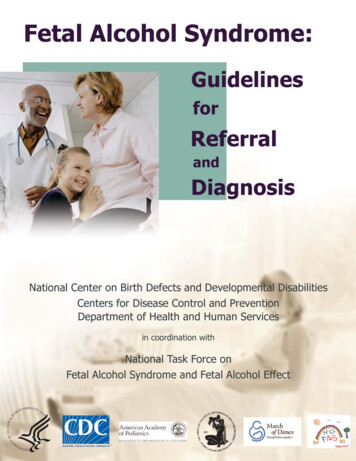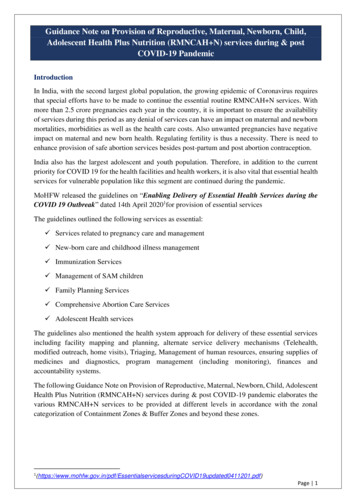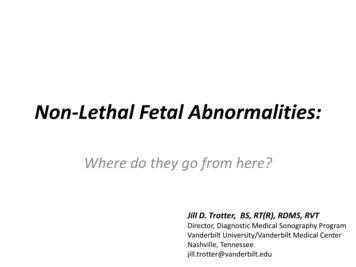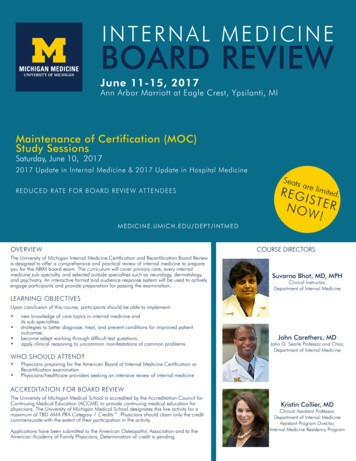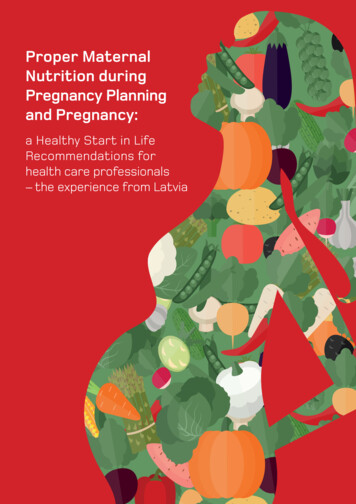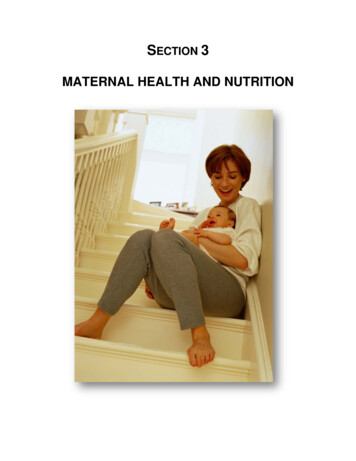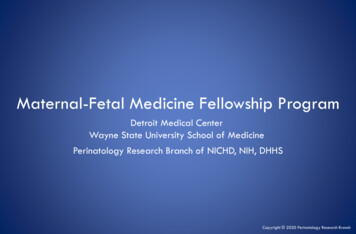
Transcription
Maternal-Fetal Medicine Fellowship ProgramDetroit Medical CenterWayne State University School of MedicinePerinatology Research Branch of NICHD, NIH, DHHSCopyright 2020 Perinatology Research Branch
Copyright 2020 Perinatology Research Branch
“The PerinatologyResearch Branch wascreated to bring alltalent, clinical andbasic, to solve theproblems that affectpregnant women andtheir unborn babies.”Roberto RomeroCopyright 2020 Perinatology Research Branch
WELCOMEWelcome to our Maternal-Fetal MedicineFellowship Training Program. Our goal is totrain individuals to provide specializedpatient care in Maternal-Fetal Medicine, aswell as to prepare candidates for a careerin academic medicine as physicianscientists. This is a combined programsponsored by the Detroit Medical Center,Wayne State University, and PerinatologyResearch Branch of NICHD, NIH, DHHS.Since 1983, our Fellowship has emphasized a diverse and multidisciplinary approach to complications of pregnancy. Fellows haveaccess to state-of-the-art equipment, dedicated laboratory andresearch space, and the opportunity to foster close relationshipswith those in other disciplines. The Fellowship emphasizes clinical,translational, and basic science research. The Perinatology ResearchBranch publishes approximately 50 peer-reviewed papers peryear and has received numerous awards for both clinical andtranslational research.Lami Yeo, MD, FACOG, FAIUM Director, DMC / WSU / PRBMaternal-Fetal Medicine Fellowship Program Associate DirectorCombined Maternal-Fetal Medicine /Medical Genetics and Genomics Fellowship Program Director of Fetal CardiologyPerinatology Research Branch, NICHD, NIH, DHHS Professor, Division of Maternal-Fetal MedicineDepartment of Obstetrics and GynecologyWayne State University School of MedicineThe Program is accredited by the ACGME and approved for sevenpositions total. Ideal candidates for the Program are well-trainedindividuals who thrive in a rigorous, intellectual, and challengingenvironment and who are goal-oriented and self-motivated. Manygraduates of our Program are leading academicians, physicianscientists, and researchers in our field. We invite you to become avalued member of our incredible team.Copyright 2020 Perinatology Research Branch
Roberto Romero, MD, D.Med.Sci. Chief, Perinatology Research BranchDirector, Division of Obstetrics and Maternal-Fetal MedicineIntramural Division, NICHD, NIH, DHHS Professor, Department of Obstetrics and GynecologyUniversity of MichiganDepartment of Epidemiology and BiostatisticsMichigan State UniversityCenter for Molecular Medicine and GeneticsWayne State University Editor-in-Chief for ObstetricsAmerican Journal of Obstetrics & GynecologyChaur-Dong Hsu, MD, MPH, FACOG Chair and Frank P. Iacobell ProfessorDepartment of Obstetrics and GynecologyWayne State University School of Medicine Specialist-in-Chief, Obstetrics and GynecologyDetroit Medical Center, Hutzel Women’s Hospital Project Site Manager - contract between WayneState University and NICHD Director, Perinatal Research InitiativeWayne State UniversityCopyright 2020 Perinatology Research Branch
Copyright 2020 Perinatology Research Branch
INTRODUCTION: Maternal-Fetal Medicine Fellowship ProgramOur Maternal-Fetal Medicine (MFM) Fellowship Programcombines the resources of: 1) the Detroit Medical Center, thelargest medical facility in Michigan; 2) the dynamic researchand teaching expertise of faculty at the Wayne StateUniversity School of Medicine; and 3) the PerinatologyResearch Branch of NICHD, NIH, DHHS. Ours is the only MFMFellowship Program affiliated with the NICHD/NIH.Fellowship Goals and Objectives: Train physicians to provide specialized patient care inMaternal-Fetal Medicine Prepare candidates for a career in academic medicine asphysician-scientistsThe Fellowship Program is housed at the Detroit Medical Centerand Wayne State University campus in Detroit, Michigan,where the Perinatology Research Branch is located. TheProgram is approved by the ACGME for seven positions.A combined Maternal-Fetal Medicine / Medical Genetics andGenomics Fellowship is also available. Candidates may alsoopt to complete a PhD degree, which is based in theDepartment of Physiology at Wayne State University.Copyright 2020 Perinatology Research Branch
Clinical CurriculumAt the Detroit Medical Center, the obstetrical and high-riskantepartum services, as well as incoming maternal transports leadto diversity and a high volume of complicated pregnancies. BothMFM Division faculty and other selected subspecialists supervisethe Fellows and offer mentorship and guidance throughout thetraining period to prepare them for independent practice withinthe subspecialty. There is a strong emphasis on the prenataldiagnosis of congenital anomalies using ultrasound, and on theperformance of antepartum procedures, intrapartum procedures,and invasive procedures, such as amniocentesis. Fellows are alsoexpected to gain competence in understanding the effects ofpregnancy on the fetus/neonate.Detroit Medical Center facilities include: Michigan’s only Maternal Special Care UnitFive-bed specialized Intensive Care Unit20 Mother/Baby UnitsNeonatal Intensive Care Unit reserved forcritically ill newborns Prematurity Prevention UnitClinical Rotations include: High-Risk Maternal-Fetal Medicine (outpatient, inpatient)Obstetrical Ultrasound and Fetal EchocardiographyLabor and DeliveryIntensive Care UnitElective rotations (e.g. Obstetric Anesthesiology, PediatricCardiology, Gynecologic Ultrasound)Copyright 2020 Perinatology Research Branch
Copyright 2020 Perinatology Research Branch
Educational CurriculumThe Fellowship includes a weekly comprehensive, broad, anddiverse educational program, which includes a daily ResearchRounds forum that is unique to our institution. Special lecturersfrom around the world are regularly invited to discuss theirwork and advances within the field. Education of Fellows isan important priority of the Program.Educational opportunities: MFM Fellowship Course Curriculum Lecture Series PRB Ultrasound Conferenceo Journal Clubo Fetal Echocardiographyo Fetal Magnetic Resonance Imagingo Ultrasound teaching lectureso Abnormal fetal case reviews and lectures Perinatal/Neonatal ConferenceDepartment of Obstetrics and Gynecology Grand RoundsAnnual OB/GYN Ultrasound SymposiumResearch Rounds at the PRBSpecial lectures hosted by the PRBAnnual Wayne Day ConferenceOther Conferences and Scientific Meetings at the PRBCopyright 2020 Perinatology Research Branch
Neutrophil extracellular traps in the human chorioamniotic membranesCopyright 2020 Perinatology Research Branch
ResearchFellows complete 18 months of research in state-of-the-artfacilities and laboratories. The Perinatology Research Branchhas both clinical and laboratory divisions available, includingan animal facility. The Program has laboratories focusing onplacental pathology, molecular biology, immunology, andcytogenetics. There is a focus on original clinical, translational,and basic research in parturition, reproductive immunology,microbiology and infectious disease, placental pathology andbiology, biomarker discovery, and systems biology inreproduction. Novel and advanced research is also conductedin fetal and maternal sonography, fetal cardiology, and fetalMRI. Scientific publications are a strong emphasis. Our Programprovides Fellows with one of the most well-developedacademic environments available in Maternal-Fetal Medicine.Placental vascular castFellows are mentored by the Faculty in combinationwith a multidisciplinary team of experts. It isexpected that a research thesis project will becompleted before graduating from the Program.Databases in multiple disciplines (e.g. imaging,placental pathology) are available, as well as aPerinatal Epidemiology Unit providing epidemiologyand biostatistical expertise.Copyright 2020 Perinatology Research Branch
Center for Advanced Obstetrical Care and Research (CAOCR)Created in collaboration with the NICHD, the Center forAdvanced Obstetrical Care and Research (CAOCR) issituated within Hutzel Women’s Hospital of the DetroitMedical Center. The CAOCR is a state-of-the-art facilitythat utilizes the most advanced surveillance andultrasound techniques. The Center evaluates high-riskpregnancy conditions by conducting ongoing researchand providing specialized patient evaluation. Researchprotocols focus on women who have a history of, or whoare at risk for: Preterm birthPregnancy lossSmall- or large-for-gestational-age fetusTwin gestationPre-eclampsiaFellows participate in the implementation of all researchprotocols and have the opportunity to learn about thedesign, execution, and analysis of longitudinal studies.Fellows also gain experience in the design and executionof randomized clinical trials.Copyright 2020 Perinatology Research Branch
C.S. Mott Center for Human Growth and DevelopmentThe C.S. Mott Center for Human Growth andDevelopment, a basic research facility housingmore than 28,000 square feet of laboratoryspace, is located on the campus of WayneState University School of Medicine. This facilityis specifically dedicated to laboratories whereresearch in Obstetrics and Gynecology isconducted. The primary mission is to fosterbasic and clinical biomedical research onreproduction and development.In addition to investigator labs, offices, and animalfacilities, the C.S. Mott Center houses: Research laboratories of the PRB Clinical Research area of the Department ofObstetrics and Gynecology Vivarium Implantation Laboratory of the ReproductiveBiology and Medicine Branch, NICHD IntramuralResearch Division Wayne State University Genomics Facility Bioinformatics Center Systems Biology sectionFetal mouseCopyright 2020 Perinatology Research Branch
Research Divisions of the Perinatology Research BranchFetal and Maternal Imaging Develop novel and innovativediagnostic techniques in fetal andmaternal imaging Conduct research of the fetusand mother utilizing three- andfour-dimensional imaging, MRI,and other sonographic modalities Study the role of fetal andmaternal imaging for theprediction of perinatal outcomeLabor and Delivery Study the mechanisms of disease ofthe Great Obstetrical Syndromes Study the progress of normal andabnormal labor Define the progesterone-regulatedmediators that allow for themaintenance of uterine quiescenceacross gestation Identify novel circulating factorsthat may serve as early predictivebiomarkers for an increased risk ofpremature laborPlacental Laboratory Study the relationship betweenplacental lesions and adversepregnancy outcomes Determine the mechanisms ofdisease underlying placentallesions Study the role of fetalmembranesinpregnancycomplicationsCopyright 2020 Perinatology Research Branch
Research Divisions of the Perinatology Research BranchFetal Cardiology Performanatomicandfunctional evaluation of thefetal heart in normal andhigh-risk pregnancies usingultrasound Improve prenatal diagnosisof congenital heart defects Develop algorithms to allowtrained clinicians to generatekey views to examine thefetal heart after acquiringsonographic volume datasetsPerinatal Immunobiology Conduct basic research on theimmunological pathways that leadto obstetrical disorders Improve understanding of theimmune mechanisms of disease Develop methods for the earlydiagnosis, monitoring, treatment,and prevention of pregnancycomplications, with an emphasis onpreterm birth Trainpost-graduateandgraduate-level professionals inperinatal immunologyBiomarkers Study the mechanisms of diseasein pregnancy complications Developnoveldiagnostic,therapeutic, and preventativestrategies to reduce perinatalmorbidity and mortalityCopyright 2020 Perinatology Research Branch
Research Divisions of the Perinatology Research BranchPerinatal Infectious Disease andHuman Microbiome Characterize the perinatal microbiomelongitudinally across pregnancy Elucidate potential interactions betweenvaginal, oral, and intestinal microbiomesand microbial invasion of the amnioticcavityBioinformatics andComputational Biology Apply advanced computationalbiology and bioinformaticsmethods to the study of clinicalconditions in Maternal-FetalMedicine Identify and evaluate specific microbialbiomarkers of obstetrical syndromes,especially preterm labor and clinicalchorioamnionitis Interpretbiologicaldataobtained via high-throughputtechnologies such as gene andmiRNA microarrays, methylationand PCR arrays, exon arrays,and sequencing technologies Manage the perinatal microbiome toprevent adverse pregnancy outcomes Perform gene ontology andpathway analysesPerinatal TranslationalScience Laboratory Study the expression and regulation ofdifferent biomarkers involved in maternaland fetal disease Conduct high-throughput technologies,such as PCR and ELISA, multiplex,Western blot, cell culture, proteinbiochemistry, and molecular biology, aswell as animal workCopyright 2020 Perinatology Research Branch
Research Divisions of the Perinatology Research BranchPerinatal Epidemiology Investigatetheantecedents,distributions, consequences, andopportunities for the prevention ofpathological perinatal outcomes,including childhood handicap withroots in pregnancy Provide training on optimal studydesigns, analytic methods, andinterpretations in the observationalinvestigations of epidemiology andthe prevention of pathologicalperinatal outcomesMolecular Evolution of Reproduction Conduct original research on theevolution of human placentationand its relationship to disease Use the tools of molecularevolutionary biology to understandthe biology of normal pregnancyand adverse pregnancy outcomeNeonatology Assess the relationship betweenmaternal, placental, neonatal,and perinatal risk factors andsubsequent infant outcomes Monitor trends in survival andtheincidenceofvariousneonatal disease entities relatedto perinatal risk factors,interventions, biochemical andbiophysical markers of diseases,and fetal growthCopyright 2020 Perinatology Research Branch
Research Divisions of the Perinatology Research BranchFetal Magnetic Resonance ImagingCytomics Develop quantitative magnetic resonanceimaging (MRI) techniques to assess fetal andneonatal brain physiology and injury Study immune responses of the mother and fetus tounderstand physiologic and pathologic pregnancyconditions Apply resting-state functional connectivityMRI to study the earliest forms of cerebralconnectivity in the human brain Conduct translational and basic science researchrelevant to normal and abnormal pregnancyconditions Apply multi-modal MRI to discover andcharacterize fetal functional and structuralbrain development in health and disease Perform immunophenotyping by polychromatic flowcytometry Sort cells with a high-speed flow cytometerCopyright 2020 Perinatology Research Branch
Scholarly ActivityFellows are exposed to research design, grantwriting, research methodology, and scientific writingthrough a breadth and depth of resources:Educational Courses and Lectures: University of Michigan Summer Session inEpidemiology Lectures on biostatistics, conceptual statistics,perinatal epidemiology, perinatal research, andbioinformatics/data analysis Lectures on basic science techniques (e.g.immunohistochemistry, proteomics) Eunice Kennedy Shriver NICHD Annual YoungInvestigator’s Conference on Maternal-FetalNeonatal-Reproductive MedicineOther Scholarly Activity: Oral or poster presentations of scientific work atlocal/national meetings and conferences Attendance at the Society for Maternal-FetalMedicine and other scientific meetings Authorship in scientific publicationsCopyright 2020 Perinatology Research Branch
Select PublicationsPique-Regi R, Romero R, Tarca AL, Luca F, Xu Y, Alazizi A, Leng Y, Hsu CD, GomezLopez N. Does the human placenta express the canonical cell entry mediators forSARS-CoV-2? Elife 2020;9:e58716.Tarca AL, Romero R, Pique-Regi R, Pacora P, Done B, Kacerovsky M, Bhatti G, JaimanS, Hassan SS, Hsu CD, Gomez-Lopez N. Amniotic fluid cell-free transcriptome: aglimpse into fetal development and placental cellular dynamics during normalpregnancy. BMC Med Genomics 2020; 13:25Jaiman S, Romero R, Pacora P, Jung E, Bhatti G, Yeo L, Kim YM, Kim B, Kim CJ, Kim JS,Qureshi F, Jacques SM, Erez O, Gomez-Lopez N, Hsu CD. Disorders of placental villousmaturation in fetal death. J Perinat Med 2020 Apr 1.Yeo L, Romero R. New and advanced features of fetal intelligent navigationechocardiography (FINE) or 5D heart. J Matern Fetal Neonatal Med 2020:1-19.Bhatti G, Romero R, Cherukuri K, Gudicha DW, Yeo L, Kavdia M, Tarca AL. Fetalgrowth percentile software: a tool to calculate estimated fetal weight percentiles for 6standards. Am J Obstet Gynecol 2020; 222:625-628.Gomez-Lopez N, Romero R, Xu Y, Miller D, Arenas-Hernandez M, Garcia-Flores V,Panaitescu B, Galaz J, Hsu CD, Para R, Berry SM. Fetal T cell activation in the amnioticcavity during preterm labor: a potential mechanism for a subset of idiopathic pretermbirth. J Immunol 2019;203:1793-1807.Theis KR, Romero R, Winters AD, Greenberg JM, Gomez-Lopez N, Alhousseini A, BiedaJ, Maymon E, Pacora P, Fettweis JM, Buck GA, Jefferson KK, Straus JF 3rd, Erez O,Hassan SS. Does the human placenta delivered at term have a microbiota? Results ofcultivation, quantitative real-time PCR, 16S rRNA gene sequencing, and metagenomics.Am J Obstet Gynecol 2019;220:267.e1-e39.Romero R, Gomez-Lopez N, Winters AD, Jung E, Shaman M, Bieda J, Panaitescu B,Pacora P, Erez O, Greenberg JM, Ahmad MM, Hsu CD, Theis KR. Evidence that intraamniotic infections are often the result of an ascending invasion – a molecularmicrobiological study. J Perinat Med 2019;47:915-931.Hernandez-Andrade E, Maymon E, Luewan S, Bhatti G, Mehrmohammadi M, Erez O,Pacora P, Done B, Hassan SS, Romero R. A soft cervix, characterized by shear-waveelastography, in women with short or with normal cervical length at 18-24 weeks isassociated with a higher prevalence of spontaneous preterm delivery. J Perinat Med2018;46:489-501.Conde-Agudelo A, Romero R, Da Fonseca E, O’Brien JM, Cetingoz E, Creasy GW,Hassan SS, Erez O, Pacora P, Nicolaides KH. Vaginal progesterone is as effective ascervical cerclage to prevent preterm birth in women with a singleton gestation, previousspontaneous preterm birth, and a short cervix: updated indirect comparison metaanalysis. Am J Obstet Gynecol 2018;219:10-25.Tarca AL, Romero R, Gudicha DW, Erez O, Hernandez-Andrade E, Yeo L, Bhatti G,Pacora P, Maymon E, Hassan SS. A new customized fetal growth standard for AfricanAmerican women: the PRB/NICHD Detroit study. Am J Obstet Gynecol 2018; 218:S679S691.e4.Krishnamurthy U, Yadav BK, Jella PK, Haacke EM, Hernandez-Andrade E, Mody S, YeoL, Hassan SS, Romero R, Neelavalli J. Quantitative flow imaging in human umbilicalvessels in utero using nongated 2D phase contrast MRI. J Magn Reson Imaging2018;48:283-289.Romero R, Conde-Agudelo A, El-Refaie W, Rode L, Brizot ML, Cetingoz E, Serra V, DaFonseca E, Abdelhafez MS, Tabor A, Perales A, Hassan SS, Nicolaides KH. Vaginalprogesterone decreases preterm birth and neonatal morbidity and mortality in womenwith a twin gestation and a short cervix: an updated meta-analysis of individual patientdata. Ultrasound Obstet Gynecol 2017;49:303-314Gomez-Lopez N, Romero R, Xu Y, Garcia-Flores V, Leng Y, Panaitescu B, Miller D,Abrahams VM, Hassan SS. Inflammasome assembly in the chorioamniotic membranesduring spontaneous labor at term. Am J Reprod Immunol 2017;77:10.1111Erez O, Romero R, Maymon E, Chaemsaithong P, Done B, Pacora P, Panaitescu B,Chaiworapongsa T, Hassan SS, Tarca AL. The prediction of late-onset preeclampsia:results from a longitudinal proteomics study. PLoS One. 2017;12:e0181468.Copyright 2020 Perinatology Research Branch
Select PublicationsKorzeniewski SJ, Romero R, Chaiworapongsa T, Chaemsaithong P, Kim CJ, Kim YM, KimJS, Yoon BH, Hassan SS, Yeo L. Maternal plasma angiogenic index-1 (placental growthfactor/soluble vascular endothelial growth factor receptor-1) is a biomarker for theburden of placental lesions consistent with uteroplacental underperfusion: a longitudinalcase-cohort study. Am J Obstet Gynecol 2016;214:629.e1-629.e17Tarca AL, Hernandez-Andrade E, Ahn H, Garcia M, Xu Z, Korzeniewski SJ, Saker H,Chaiworapongsa T, Hassan SS, Yeo L, Romero R. Single and Serial Fetal Biometry toDetect Preterm and Term Small- and Large-for-Gestational-Age Neonates: ALongitudinal Cohort Study. PLoS One 2016;11:e0164161Hsu C-D, Cohn, I, Caban, R. Reduction and sustainability of Cesarean section surgicalsite infection: an evidence-based, innovative, and multidisciplinary quality improvementintervention bundle program. Am J Infect Control 2016; 44:1315-1320Krishnamurthy U, Neelavalli J, Mody S, Yeo L, Jella PK, Saleem S, Korzeniewski SJ,Cabrera MD, Ehterami S, Bahado-Singh RO, Katkuri Y, Haacke EM, HernandezAndrade E, Hassan SS, Romero R. MR imaging of the fetal brain at 1.5T and 3.0T fieldstrengths: comparing specific absorption rate (SAR) and image quality. J Perinat Med2015;43:209-220Mazaki-Tovi S, Vaisbuch E, Tarca AL, Kusanovic JP, Than NG, Chaiworapongsa T, DongZ, Hassan SS, Romero R. Characterization of visceral and subcutaneous adipose tissuetranscriptome and biological pathways in pregnant and non-pregnant women: evidencefor pregnancy-related regional-specific differences in adipose tissue. PLoS One2015;10:e0143779.Neelavalli J, Mody S, Yeo L, Jella PK, Korzeniewski SJ, Saleem S, Katkuri Y, BahadoSingh RO, Hassan SS, Haacke EM, Romero R, Thomason ME. MR venography of the fetalbrain using susceptibility weighted imaging. J Magn Reson Imaging 2014;40:949-957Romero R, Dey SK, Fisher SJ. Preterm labor: one syndrome, many causes. Science2014;345:760-765Yeo L, Romero R. Fetal intelligent navigation echocardiography (FINE): a novel methodfor rapid, simple, and automatic examination of the fetal heart. Ultrasound ObstetGynecol 2013; 42:268-284Chaiworapongsa T, Romero R, Korzeniewski SJ, Kusanovic JP, Soto E, Lam J, Dong Z,Than NG, Yeo L, Hernandez-Andrade E, Conde-Agudelo A, Hassan SS. Maternal plasmaconcentrations of angiogenic/antiangiogenic factors in the third trimester of pregnancy toidentify the patient at risk for stillbirth at or near term and severe late preeclampsia. AmJ Obstet Gynecol 2013;208:287.e1-287.e15Hernandez-Andrade E, Hassan SS, Ahn H, Korzeniewski SJ, Yeo L, Chaiworapongsa T,Romero R. Evaluation of cervical stiffness during pregnancy using semiquantitativeultrasound elastography. Ultrasound Obstet Gynecol 2013; 4Z:152-161Thomason, M.E., Dassanayake, M.T., Shen, S., Katkuri, Y., Alexis, M., Anderson, A.L., Yeo,L., Mody, S., Hernandez-Andrade, E., Hassan, S.S., Studholme, C., Jeong, J.W., &Romero, R. Cross-hemispheric functional connectivity in the human fetal brain. ScienceTranslational Medicine 2013;5:17324Kim CJ, Romero R, Chaemsaithong P, Chaiyasit N, Yoon BH, Kim YM. Acutechorioamnionitis and funisitis: definition, pathologic features, and clinical significance.Am Obstet Gynecol 2015;213:S29-52.Romero R, Nicolaides K, Conde-Agudelo A, Tabor A, O'Brien JM, Cetingoz E, Da FonsecaE, Creasy GW, Klein K, Rode L, Soma-Pillay P, Fusey S, Cam C, Alfirevic Z, Hassan SS.Vaginal progesterone in women with an asymptomatic sonographic short cervix in themidtrimester decreases preterm delivery and neonatal morbidity: a systematic reviewand meta-analysis of individual patient data. Am J Obstet Gynecol 2012;124.e1-19Romero R, Miranda J, Chaiworapongsa T, Korzeniewski SJ, Chaemsaithong P, Gotsch F,Dong Z, Ahmed AI, Yoon BH, Hassan SS, Kim CJ, Yeo L. Prevalence and clinicalsignificance of sterile intra-amniotic inflammation in patients with preterm labor andintact membranes. Am J Reprod Immunol 2014; 72:458-474Kannan S, Dai H, Navath RS, Balakrishnan B, Jyoti A, Janisse J, Romero R, Kannan RM.Dendrimer-based postnatal therapy for neuroinflammation and cerebral palsy in arabbit model. Sci Transl Med 2012;4:130ra46Copyright 2020 Perinatology Research Branch
Select PublicationsYeo L, Romero R, Jodicke C, Ogge G, Lee W, Kusanovic JP, Vaisbuch E, Hassan S.Four-chamber view and "swing technique" (FAST) echo: a novel and simple algorithm tovisualize standard fetal echocardiographic planes. Ultrasound Obstet Gynecol 2011;37:423-431.Lee W, Balasubramaniam M, Deter RL, Hassan SS, Gotsch F, Kusanovic JP, Gonçalves LF,Romero R. Fractional limb volume--a soft tissue parameter of fetal body composition:validation, technical considerations and normal ranges during pregnancy. UltrasoundObstet Gynecol 2009;33:427-440.Lee J, Romero R, Xu Y, Kim JS, Topping V, Yoo W, Kusanovic JP, Chaiworapongsa T,Hassan SS, Yoon BH, Kim CJ. A signature of maternal anti-fetal rejection in spontaneouspreterm birth: chronic chorioamnionitis, anti-human leukocyte antigenantibodies, andC4d. PLoS One 2011;6:e16806Espinoza J, Gonçalves LF, Romero R, Nien YK, Stites S, Kim YM, Hassan S, Gomez R, YoonBH, Chaiworapongsa T, Lee W, Mazor M. The prevalence and clinical significance ofamniotic fluid “sludge” in patients with preterm labor and intact membranes. UltrasoundObstet Gynecol 2005; 25:346-352.Mittal P, Romero R, Tarca AL, Draghici S, Nhan-Chang CL, Chaiworapongsa T, Hotra J,Gomez R, Kusanovic JP, Lee DC, Kim CJ, Hassan SS. A molecular signature of an arrestof descent in human parturition. Am J Obstet Gynecol 2011;204:177.e15-33Condon JC, Jeyasuria P, Faust JM, Wilson JW, Mendelson CR. A decline in the levels ofprogesterone receptor coactivators in the pregnant uterus at term may antagonizeprogesterone receptor function and contribute to the initiation of parturition. Proc NatlAcad Sci USA 2003;100:9518-9523.Hassan SS, Romero R, Vidyadhari D, Fusey S, Baxter J, Khandelwal M, VijayaraghavanJ, Trivedi Y, Soma-Pillay P, Sambarey P, Dayal A, Potapov V, O'Brien J, Astakhov V,Yuzko O, Kinzler W, Dattel B, Sehdev H, Mazheika L, Manchulenko D, Gervasi MT,Sullivan L, Conde-Agudelo A, Phillips JA, Creasy GW; for the PREGNANT Trial.Vaginal progesterone reduces the rate of preterm birth in women with a sonographicshort cervix: a multicenter, randomized, double-blind, placebo-controlled trial.Ultrasound Obstet Gynecol 2011; 38:18-31Gonçalves LF, Lee W, Chaiworapongsa T, Espinoza J, Schoen ML, Falkensammer P,Treadwell M, Romero R. Four dimensional ultrasonography of the fetal heart withspatiotemporal image correlation. Am J Obstet Gynecol 2003;189:1792-802.Kim YM, Bujold E, Chaiworapongsa T, Gomez R, Yoon BH, Thaler HT, Rotmensch S,Romero R. Failure of the physiologic transformation of the spiral arteries in patients withpreterm labor and intact membranes. Am J Obstet Gynecol 2003;189:1063-1069.Espinoza J, Lee W, Comstock C, Romero R, Yeo L, Rizzo G, Paladini D, Viñals F, AchironR, Gindes L, Abuhamad A, Sinkovskaya E, Russell E, Yagel S. Collaborative study on 4dimensional echocardiography for the diagnosis of fetal heart defects: the COFEHDstudy. J Ultrasound Med 2010; 29:1573-1580Jacques SM, Qureshi F. Chronic chorioamnionitis: Aimmunohistochemical study. Hum Pathol 1998; 29:1457-1461.Conde-Agudelo A, Romero R. Antenatal magnesium sulfate for the prevention ofcerebral palsy in preterm infants less than 34 weeks' gestation: a systematic reviewand metaanalysis. Am J Obstet Gynecol 2009;200:595-609Romero R, Yoon BH, Mazor M, Gomez R, Gonzalez R, Diamond MP, Baumann P,Araneda H, Kenney JS, Cotton DB, et al. A comparative study of the diagnosticperformance of amniotic fluid glucose, white blood cell count, interleukin-6, and gramstain in the detection of microbial invasion in patients with preterm premature rupture ofmembranes. Am J Obstet Gynecol 1993;169:839-851Kim MJ, Romero R, Kim CJ, Tarca AL, Chhauy S, LaJeunesse C, Lee DC, Draghici S,Gotsch F, Kusanovic JP, Hassan SS, Kim JS. Villitis of unknown etiology is associatedwith a distinct pattern of chemokine up-regulation in the feto-maternal and placentalcompartments: Implications for conjoint maternal allograft rejection and maternal antifetal Graft versus Host Disease. J Immunol 2009;182:3919-3927.Romero R, Brody DT, Oyarzun E, Mazor M, Wu YK, Hobbins JC, Durum SK. Infection andlabor. III. Interleukin-1: a signal for the onset of parturition. Am J Obstet Gynecol1989;160(5 Pt 1):1117-1123clinicopathologicandCopyright 2020 Perinatology Research Branch
Division of Maternal-Fetal MedicineWayne State University School of MedicineThe Division of Maternal-Fetal Medicine is comprised offaculty members who are recognized internationally formaking seminal contributions to our discipline, andprovide expert evaluation and highly specialized care towomen with high-risk and complicated pregnancies.Clinical care includes providing pre-conceptional andprenatal consultation as well as performing advancedtechniques, such as:The Wayne State University Department of Obstetricsand Gynecology has been an internationallyrecognized academic center in women’s health andchild development for more than 50 years. TheDepartment is committed to improving the health andwell-being of women, infants, and families ofSoutheast Michigan and the surrounding areas. Obstetrical ultrasonographyAntepartum fetal health assessmentAmniocentesisUmbilical fetal blood samplingFetal echocardiographyDoppler assessment of the mother and fetusMFM physicians are available for consultation 24 hours aday, and provide Labor and Delivery services at HutzelWomen’s Hospital. The education and training ofMaternal-Fetal Medicine fellows is an integral part of theDivision’s mission.Copyright 2020 Perinatology Research Branch
Perinatology Research Branch Faculty In addition to our distinguished faculty, the Fellowshave the opportunity to collaborate withinternational scholars, research associates, andphysician-scientists on sabbatical at the PerinatologyResearch Branch The PRB has hosted Nobel Laureates, Royal SocietyFellows, members of the National Ac
Michigan State University Center for Molecular Medicine and Genetics Wayne State University . diagnostic techniques in fetal and maternal imaging Conduct research of the fetus and mother utilizing three- and four-d
